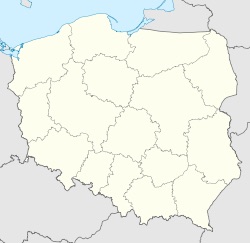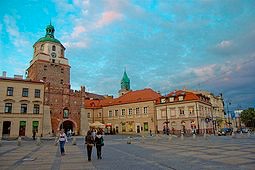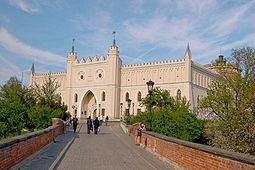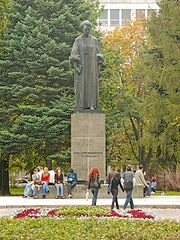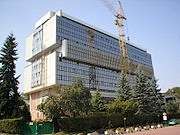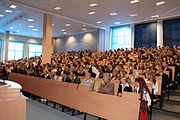Lublin, Poland
Lublin
From Wikipedia, the free encyclopedi
Lublin
Top: panorama of Old Town Lublin, including Crown Tribural Second left: façade buildings in Staego Street. Second right: Lublin Castle. Third left: view of Tynitarska Tower, Cracow Gate, and many of historical built from Miasto Square. Third right: Tentement house in Klonawica Street, Bottom: view of Plac po Farze area
Flag
Coat of arms

Lublin
Country
city county
Established
before 12th century
Town rights
1317
Government
• Mayor
Krzysztof Zuk
Area
• City
147 km2 (57 sq mi)
Population (2009)
• City
349,103
• Density
2,400/km2 (6,200/sq mi)
• Metro
664,000
• Summer (DST)
Postal code
20-001 to 20-999
+48 81
LU
Website
http://www.um.lublin.pl/ http://www.lublin.eu/en
Cracow Gate in the Old Town is among the most recognizable landmarks of the city.
Another characteristic building in Lublin is the Royal Castle.
History
The first permanent settlements on the future site of Lublin were established in the early Middle Ages, though archeological finds indicate a long, earlier presence of cultures in the general area. The earliest, most significant settlement began in the 6th century on a hill in the suburb of Czwartek (in Polish Thursday, most likely in reference to the market day of the settlement). It is likely that the surrounding hills, site of the present day Old Town, were settled at this time. In the 10th and 11th centuries, the Czwartek settlement became an important trade centre. The location of Lublin at the eastern borders of the Polish lands gave it military significance. The first fortification on the site may have been built as early as the 8th century, possibly on the Castle Hill. Certainly at the end of the 10th century a significant fortification existed there. As the castle grew, the Old Town hill adjacent to it became the main focus of settlement, and the Czwartek settlement declined in relative importance. The castle became the seat of a Castellan, first mentioned in historical sources from 1224, but quite possibly present from the start of the 12th or even 10th century. The oldest historical document mentioning Lublin dates from 1198, so the name must have come into general use some time earlier.
The city was a target of attacks by Tatars, Ruthenes, Yotvingians, and Lithuanians and was destroyed several times. It received a city charter in 1317. Casimir the Great, appreciating the site's strategic importance, built a masonry castle in 1341 and encircled the city with defensive walls.
In 1392, the city received an important trade privilege from king Władysław Jagiełło, and with the coming of the peace between Poland and Lithuania developed into a trade centre, handling a large portion of commerce between the two countries. In 1474 the area around Lublin was carved out of Sandomierz Voivodeship and combined to form the Lublin Voivodeship, the third voivodeship of Lesser Poland. During the 15th century and 16th century the town grew rapidly. The largest trade fairs of the Polish-Lithuanian Commonwealth were held in Lublin. During the 16th century the noble parliaments (sejm) were held in Lublin several times. On June 26, 1569, one of the most important proclaimed the Union of Lublin, which united Poland and Lithuania. The Lithuanian name for the city is Liublinas.
Some of the artists and writers of the 16th century Polish renaissance lived and worked in Lublin, including Sebastian Klonowic and Jan Kochanowski, who died in the city in 1584. In 1578 the Crown Tribunal, the highest court of the Lesser Poland region, was established in Lublin.
Since the second half of the 16th century, Protestant Reformation movements devolved in Lublin, and a large congregation of Polish Brethren was present in the city. One of Poland's most important Jewish communities was also established in Lublin around this time. Jews established a widely respected yeshiva, Jewish hospital, synagogue, cemetery, and education center (kahal) and built the Grodzka Gate (known as the Jewish Gate) in the historic district. Jews were a vital part of the city's life until they were destroyed in the Nazi Holocaust. Between 1580 and 1764 the Jewish Council of Four Lands Arba Aracot (Sejm of four countries) was held in Lublin in which approximately seventy delegates from local kahals met to discuss taxation and other issues important to Jewish communities.
Students came to Lublin from all over Europe to study at the yeshiva there. The yeshiva became a centre of learning of both Talmud and Kabbalah, leading the city to be called "the Jewish Oxford"; in 1567, the rosh yeshiva (headmaster) received the title of rector from the king along with rights and privileges equal to those of the heads of Polish universities.
In the 17th century, the town declined due to a Russo-Ukrainian invasion in 1655 and a Swedish invasion during the Northern Wars. After the third of the Partitions of Poland in 1795 Lublin was located in the Austrian empire, then since 1809 in the Duchy of Warsaw, and then since 1815 in the Congress Poland under Russian rule. At the beginning of the 19th century new squares, streets, and public buildings were built. In 1877 a railway connection to Warsaw and Kovel and Lublin Station were constructed, spurring industrial development. Lublin's population grew from 28,900 in 1873 to 50,150 in 1897 (including 24,000 Jews).[1]
Russian rule ended in 1915, when the city was occupied by German and Austro-Hungarian armies. After the defeat of the Central Powers in 1918, the first government of independent Poland operated in Lublin for a short time. In the interwar years, the city continued to modernize and its population grew; important industrial enterprises were established, including the first aviation factory in Poland, the Plage i Laśkiewicz works, later nationalized as the LWS factory. The Catholic University of Lublin was founded in 1918. The city also contained a vibrant Jewish community that comprised nearly half of Lublin's population.
After the 1939 German invasion of Poland the city found itself in the General Government. During the German occupation the city's population was a target of severe Nazi oppression focusing on Jews. Germans aimed to "Germanise" the city with an influx of ethnic Germans growing toward 20%-25%, compared with 10%-15% in 1939.[2] Near Lublin, a reservation for Jews was built on the Nisko Plan, also known as the "Lublin Plan".
The city served as a headquarters for Operation Reinhardt, the main German effort to exterminate the Jews in occupied Poland. The Jewish population was forced into a ghetto near Podzamcze. The majority of the ghetto's inhabitants, about 26,000 people, was deported to the Bełżec extermination camp between 17 March and 11 April 1942. The remainder were moved to facilities around the Majdanek concentration camp established at the outskirts of the city. Most of them had been murdered by war's end.
Further information: The Holocaust in Poland
After the war, the few surviving Jews in hiding or Soviet territory reestablished a small Jewish community in the city, but it quickly shrank to insignificance, as most Jews left Poland for Israel and the West.
Maria Curie-Sklodowska University
On 24 July 1944, the city was taken by the Soviet Army and became the temporary capital of a Soviet-controlled communist Polish Committee of National Liberation established in the city, which was to serve as basis for a puppet government. The capital was moved to Warsaw in January 1945. In the postwar years Lublin continued to grow, tripling its population and greatly expanding in area. A considerable scientific and research base was established around the newly founded Maria Curie-Sklodowska University. A large automobile factory (FSC) was established in the city.
In July 1980, the workers of Lublin and nearby Świdnik began the first in the wave of mass strikes aimed against the Communist regime, which eventually led to the emergence of the Solidarity movement. The first strike began on July 8 in the WSK factory in Świdnik. It then quickly spread to other factories in Lublin and the surrounding region. The railroad network and city transit came to a standstill. Ultimately, 150 factories employing 50,000 workers joined the strike. The strikers used a novel tactic of staying inside their factories and occupying them, instead of marching in the streets where the authorities would have found it easy to use force against them. The workers made demands for their economic situation to be improved. They also made political demands, such as: new elections for the leadership of the trade unions, liquidation of privileges for the Communist party governing class, and the reduction of the bureaucracy in the factories.
The July strikes lasted two weeks. The Communist authorities eventually managed to bring them to an end peacefully, mainly by granting economic concessions to the workers. However, the momentum generated by the Lublin strikes quickly gave rise to a new wave of strikes in the Gdańsk region in August 1980. The workers there used similar tactics as the Lublin workers used a month before, and this time the Communist authorities had to agree to the strikers' demand to set up an independent trade union, which soon became the Solidarity.
European capital of culture
In 2007, Lublin joined the group of Polish cities which were candidates for the title of European Capital of Culture, as one two cities from the eastern half of Poland the other being Białystok. Lublin won through to the second round with Spain in 2016 but ultimately Wrocław was chosen.
"Lublin is the city that symbolises European idea of integration, universal heritage of democracy and tolerance and the idea of dialogue between the cultures of the West and East. Lublin is a unique place where the cultures and religions meet. Here the East meets West, and the European Union meets Belarus and Ukraine. It is the perfect place of cooperation for European artists living within and outside the European Union. Lublin is a city open to artists, a place where unique initiatives and activities take place. Lublin means the experience of hundreds of years of rich history and cultural heritage which constitutes endless source of inspiration for new generations.
European Culture is not only modern museums and enormous festivals, but first of all people and their activities, aims, aspirations, possibilities, potential and the desire for development.The development of culture and being granted the title of European Capital of Culture is a chance for development of one the poorest regions of the European Union."[22] — Adam Wasilewski, President of Lublin
Since 2007, there are special meetings, enter2016, which anyone could take part in. The City's Marketing Office have created a web page: Lublin2016.eu, available in Polish, English, Ukrainian, Spanish and Portuguese.
Lublin is a pilot city of the Council of Europe and the European Commission Intercultural cities programme.
Education
John Paul II Catholic University of Lublin
WSPA lecture hall
There are six schools of higher education, including Maria Curie-Sklodowska University (UMCS) and John Paul II Catholic University of Lublin (JPII CUL).
-
•Medical University of Lublin – [9] (Medical University of Lublin)
-
•John Paul II Catholic University of Lublin (KUL) – Catholic University of Lublin
Lublin hosts a number of private higher education establishments.
The Polish government has plans to establish a new university in Lublin in cooperation with the Ukraine government, which promises to be one of the most innovative international ventures of recent years.[citation needed] The Polish-Ukrainian Academy will support multicultural exchange, and will highlight Polish and Ukrainian heritage and history. It promises to be a milestone in the rapprochement between Poland and Ukraine, and between Ukraine and the European Union.
-
•University of Economics and Innovation in Lublin – [11]
-
•Lubelska Szkoła Biznesu– [12]
-
•Wyższa Szkoła Nauk Społecznych z siedzibą w Lublinie – [13]
-
•Wyższa Szkoła Przedsiębiorczości i Administracji – [14]
-
•Wyższa Szkoła Społeczno-Przyrodnicza w Lublinie – [15]
Notable residents
-
•Jacek Bąk, Polish footballer and captain of Poland during World Cup 2006
-
•Katarzyna Dolinska of America's Next Top Model, Cycle 10, came in 5th place
-
•Rabbi Jacob ben Ephraim (unknown-1648) - "The Gaon Rabbi Jacob of Lublin"
-
•Rabbi Joshua Falk (1555–1614), also known as Joshua ben Alexander HaCohen Falk
-
•Rabbi Shneur Zalman Fradkin (1830-1902) - "The Toras Chessed"
-
•Rabbi Aryeh Tzvi Frumer (1884-1943) - "The Kozhiglover Rav", Holocaust victim
-
•Jacob Glatstein (1896–1971), literary critic
-
•Alter Mojze Goldman (1909–1988), resistance fighter
-
•Rabbi Zadok HaKohen Rabinowitz (1823-1900)
-
•Kitty Hart-Moxon (1926-), Holocaust survivor
-
•Rabbi Moses Isserles (1520-1572) - "Rema"
-
•Albert Kitmacher (1920–2000), Holocaust survivor
-
•Felix Lembersky (1913-1970), artist, painter
-
•Janusz Lewandowski (1951-), MEP, former minister of privatization
-
•Rabbi Solomon Luria (1510-1573) - "The Maharshal"
-
•Wincenty Pol (1807-1872), poet and geographer
-
•Rabbi Jacob Pollak (1460-1541)
-
•Stanisław Kostka Potocki (1755–1821), Polish nobleman, politician, and writer
-
•Rabbi Sholom Rokeach (1781-1855) - "Sar Sholom", the first Belzer Rebbe
-
•Yitzhak Sadeh (born Isaac Landsberg; 1890-1952), a founder of the Israel Defense Forces
-
•Rabbi Shalom Shachna (unknown-1558)
-
•Rabbi Meir Shapiro (1887-1933) - "The Lubliner Rav"
-
•Rabbi Joel Sirkis (1561-1640), also known as Joel ben Samuel Sirkis
-
•Henryk Wieniawski (1835–1880), violinist; born in Lublin
-
•Rabbi Yaakov Yitzchak of Lublin (1745–1815) - "The Seer of Lublin"
-
•Rabbi Mordecai Yoffe (1530-1612) - "The Levush"
-
•Wladyslaw Zmuda, Polish footballer and four-time World Cup participant
-
•Henio Zytomirski (1933-1942), Holocaust victim
-
•Konrad "Mokate" Kukier (1988-), Professional League of Legends gamer, he plays the jungling role for the team "Meet Your Makers"
International relations
-
•Lublin is a pilot city of the Council of Europe and the EU Intercultural cities programme.[23]
Twin towns — sister cities
See also: List of twin towns and sister cities in Poland
Lublin is twinned with:[24]






